You could use the Quadratic Formula for everything, but the Formula can be "overkill". For example:
- Solve (x + 1)(x – 3) = 0.
- This is a quadratic, and I'm supposed to solve it. I could multiply the left-hand side, simplify to find the coefficients, plug them into the Quadratic Formula, and chug away to the answer.
But why would I? I mean, for heaven's sake, this is factorable, and they've already factored it and set it equal to zero for me. While the Quadratic Formula would give me the correct answer, why bother with it? Instead, I'll just solve the factors:
- (x + 1)(x – 3) = 0 x + 1 = 0 or x – 3 = 0 x = –1 or x = 3
The solution is x = –1, 3
- Solve x2 + x – 4 = 0.
- This one doesn't factor (since there are no factors of (1)(–4) = –4 that add to +1), and this isn't formatted as "(squared part) equals (a number)", so I can't use square-rooting to solve. This leaves me with completing the square (yuck!) or the Quadratic Formula. I'll use the Formula:
![x = [-1 ± sqrt(17)] / 2](http://www.purplemath.com/modules/quads/solve11.gif)
- Solve x2 – 3x – 4 = 0.
- This one factors easily:
- x2 – 3x – 4 = 0 (x + 1)(x – 4) = 0 x + 1 = 0 or x – 4 = 0 x = –1 or x = 4
The solution is x = –1, 4
- Solve x2 – 4 = 0.
- This quadratic has just two terms, and nothing factors out of both, so it's a difference of squares (so I can factor) or it can be reformatted as "(squared part) equals (a number)" so I can square-root both sides. In this case, I can factor:
- x2 – 4 = 0 (x + 2)(x – 2) = 0 x + 2 = 0 or x – 2 = 0 x = –2 or x = 2
The solution is x = ± 2
- Solve 6x2 + 11x – 35 = 0.
- This may factor, but it looks like it would be a fair amount of work, and I'm feeling a bit mindless and lazy at the moment, so I'll use the Quadratic Formula instead:

- The solution is x = –7/2, 5/3
- Solve x2 – 48 = 0.
- This is two terms, and nothing factors out, so either it's a difference of squares (so I can factor) or else it can be formatted as "(squared part equals) a (number)" so I can square-root both sides. Since 48 is not a square, I have to square-root both sides:
- Solve x2 – 7x = 0.
- This quadratic factors easily: Copyright © Elizabeth Stapel 2002-2011 All Rights Reserved
- x2 – 7x = 0 x(x – 7) = 0 x = 0 or x – 7 = 0 x = 0 or x = 7
The solution is x = 0, 7

